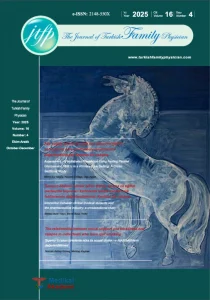Evaluation of empathic tendency and comunication skills in grade 3 students in faculty of medicine
Aim: The aim of our study; to gather information about medical students’ empathy tendency level and ommunication skills attitudes and to make suggestions for shaping education with the results.
Method: In this study, before the communication skills course of Düzce University Faculty of Medicine, to determine the students’ empathy tendency and communication skills attitudes, students were asked to fill in the “Empathic Tendency Scale” (EEÖ), which consists of 20 questions developed by Dökmen (1988) and “Developing Communication Skills Assessment Scale” consisting of 25 questions developed by Korkut (İBDO).
Results: Of the 94 students, 51.1% (s = 46) were male and 48.9% (s = 46) were female. The rate of students who had previously learned about empathic tendency (29.8%) was significantly lower than the rate of non-knowledgeable students (70.2%). Again, the rate of students who had previously been informed about communication skills (23.4%) was significantly lower than the rate of non-knowledgeable students (76.6%). When the information sources of the individuals who were informed about empathic tendency were examined, it was observed that 39.4% of the individuals were internet, 39.4% of them were books and 21.4% of them were seminar, but there was no significant difference between the rates. There was a positively low correlation between empathic tendency total scale score and communication skills total scale score. According to the gender, there was no significant difference in the mean rank values of the empathic tendency scale. There is a significant difference in terms of average rank value of communication skills scale by gender. Female students’ communication skills, total scale average rank value, communication skills of men were found to be significantly higher than total scale average rank value.
Conclusion: In the process of physician-patient relationship, the impressions obtained during the interviews are very important for the definition and solution of the problem. In order to make an effective evaluation, empathy tendency is as important as the training, knowledge and experience of the doctor. During the medical education, prospective physicians are required to be active in the education curriculum in order to improve their empathy sensitivity and communication skills. It is suggested that the studies will provide awareness in terms of dissemination of communication skills education in medical education.
References
- Määttä SM. Closeness and distance in the nurse-patient relation. The relevance of Edith Stein’s concept of empathy. Nurs Philos 2006; 7(1):3-10.
- Barrett-Lennard GT. The phases and focus of empathy. Br J Med Psychol Review 1993; 66:3-14.
- Karaca A, Açıkgöz F, Akkuş D. Eğitim ile empatik beceri ve empatik eğilim geliştirilebilir mi?: Bir sağlık yüksekokulu örneği. Acıbadem Üniversitesi Sağlık Bilimleri Dergisi 2013; 4(3):118-122.
- Babadağlı B, Erim S, Erdoğan S. Hekimlerin ve hemşirelerin hastayla iletişim becerilerinin değerlendirilmesi. Fırat Sağlık Hizmetleri Dergisi 2006;1:52-69.
- Korkut F. İletişim becerilerini değerlendirme ölçeğinin geliştirilmesi: Güvenirlik ve geçerlik çalışmaları. Psikolojik Danışma ve Rehberlik Dergisi 1996; 2 (7):18-23.
- Dökmen Ü. Empatinin yeni bir modele dayanılarak ölçülmesi ve psikodrama ile ölçülmesi. A.Ü. Eğitim Bilimleri Dergisi 1988; 21(1-2):155-90.
- Aomatsu M, Otani T, Tanaka A, Ban N, van Dalen J. Medical students’ and residents’ conceptual structure of empathy: a qualitative study. Educ Health (Abingdon) 2013; 26(1):4-8.
- Ahmadian YN, Bigdeli S, Soltani ASK, Ghaffarifar S. The influence of role-modeling on clinical empathy of medical interns: A qualitative study. J Adv Med Educ Prof 2019; 7(1):35-41.
- Yiğitbaş Ç, Deveci SE, Açık Y, Ozan AT, Oğuzöncül AF. Sağlık eğitimi alan bir grup öğrencinin empatik eğilim ve becerisi. SDÜ Sağlık Bi-limleri Dergisi 2013;4(1): 7-13.
- Tutuk A, Al D, Doğan S. Hemşirelik öğrencilerinin iletişim becerisi ve empati düzeylerinin belirlenmesi. C. Ü. Hemşirelik Yüksek Okulu Dergisi 2002; 6 (2):36-41.
- Görmüş A.Ş, Aydın S, Erin G. İşletme bölümü öğrencilerinin iletişim becerilerinin cinsiyet rolleri bağlamında incelenmesi. Sosyal Bilimler Dergisi 2013; 15(1):109-28.
- Haque M, Sa B, Majumder MAA, Islam MZ, Othman NSAB, Lutfi SNNB, et al. Empathy among undergraduate medical students: A cross-section al study in one Malaysian public medical school. Ann Afr Med 2018; 17(4):183-8.
- Korkut F. Hacettepe Üniversitesi Eğitim Fakültesi Dergisi 2005; 28:143-9.
- Özerbaş MA, Bulut M, Usta E. Ahi Evran Üniversitesi Kırşehir Eğitim Fakültesi Dergisi (KEFAD) 2007; 8(1):123-35.
- Dişcigil G, Dikici F, Yarış F, Başak O. Tıp fakültesi öğrencilerinin klinik iletişim becerilerinin standardize hastayla değerlendirmesi ile ilgili görüşleri. Türk Aile Hek Derg 2009; 13(1):23-6.
- Uluoğlu C, Şahin F, Yüce S, Yamaç D, Güney HZ, Çırak MY, ve ark. Temel iletişim becerileri: Amaç ve öğrenim hedefleri ‘Gazi Üniversitesi Tıp Fakültesi Dönem I Uygulamaları’. Tıp Eğitimi Dünyası 2007; 24:39-45.
- Arifoğlu B, Razı GS. Birinci sınıf hemşirelik öğrencilerinin empati ve iletişim becerileriyle İietişim yönetimi dersi akademik başarı puanı arasındaki ilişki. DEUHYO ED 2011; 4(1):7-11.1
- Öz, F. Impact of training on empathic communication skills and tendency of nurses. Clinical Excellence for Nurse Practitioners 2001; 5 (1):44-51.
- McWhinney: Aile Hekimliği. (çev.ed) Güldal D. 4. baskı. Adana, Çukurova Nobel Tıp Kitabevi. 2016: 173-201.



